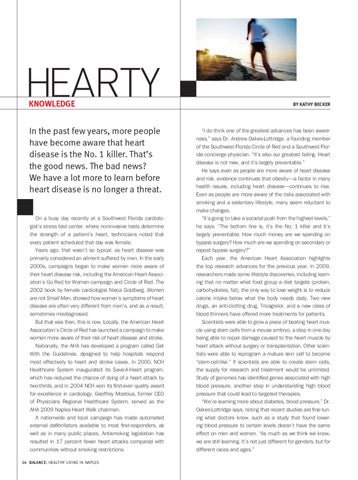HEARTY KNOWLEDGE
In the past few years, more people have become aware that heart disease is the No. 1 killer. That’s the good news. The bad news? We have a lot more to learn before heart disease is no longer a threat. On a busy day recently at a Southwest Florida cardiologist’s stress test center, where noninvasive tests determine the strength of a patient’s heart, technicians noted that every patient scheduled that day was female. Years ago, that wasn’t so typical, as heart disease was primarily considered an ailment suffered by men. In the early 2000s, campaigns began to make women more aware of their heart disease risk, including the American Heart Association’s Go Red for Women campaign and Circle of Red. The 2002 book by female cardiologist Nieca Goldberg, Women are not Small Men, showed how women’s symptoms of heart disease are often very different from men’s, and as a result, sometimes misdiagnosed. But that was then, this is now. Locally, the American Heart Association’s Circle of Red has launched a campaign to make women more aware of their risk of heart disease and stroke. Nationally, the AHA has developed a program called Get With the Guidelines, designed to help hospitals respond most effectively to heart and stroke cases. In 2000, NCH Healthcare System inaugurated its Save-A-Heart program, which has reduced the chance of dying of a heart attack by two-thirds, and in 2004 NCH won its first-ever quality award for excellence in cardiology. Geoffrey Moebius, former CEO of Physicians Regional Healthcare System, served as the AHA 2009 Naples Heart Walk chairman. A nationwide and local campaign has made automated external defibrillators available to most first-responders, as well as in many public places. Antismoking legislation has resulted in 17 percent fewer heart attacks compared with communities without smoking restrictions. 24 BALANCE: HEALTHY LIVING IN NAPLES
BY KATHY BECKER
“I do think one of the greatest advances has been awareness,” says Dr. Andrew Oakes-Lottridge, a founding member of the Southwest Florida Circle of Red and a Southwest Florida concierge physician. “It’s also our greatest failing. Heart disease is not new, and it’s largely preventable.” He says even as people are more aware of heart disease and risk, evidence continues that obesity—a factor in many health issues, including heart disease—continues to rise. Even as people are more aware of the risks associated with smoking and a sedentary lifestyle, many seem reluctant to make changes. “It’s going to take a societal push from the highest levels,” he says. “The bottom line is, it’s the No. 1 killer and it’s largely preventable. How much money are we spending on bypass surgery? How much are we spending on secondary or repeat bypass surgery?” Each year, the American Heart Association highlights the top research advances for the previous year. In 2009, researchers made some lifestyle discoveries, including learning that no matter what food group a diet targets (protein, carbohydrates, fat), the only way to lose weight is to reduce calorie intake below what the body needs daily. Two new drugs, an anti-clotting drug, Tricagrelor, and a new class of blood thinners have offered more treatments for patients. Scientists were able to grow a piece of beating heart muscle using stem cells from a mouse embryo, a step in one day being able to repair damage caused to the heart muscle by heart attack without surgery or transplantation. Other scientists were able to reprogram a mature skin cell to become “stem-cell-like.” If scientists are able to create stem cells, the supply for research and treatment would be unlimited. Study of genomes has identified genes associated with high blood pressure, another step in understanding high blood pressure that could lead to targeted therapies. “We’re learning more about diabetes, blood pressure,” Dr. Oakes-Lottridge says, noting that recent studies are fine-tuning what doctors know, such as a study that found lowering blood pressure to certain levels doesn’t have the same effect on men and women. “As much as we think we know, we are still learning. It’s not just different for genders, but for different races and ages.”
